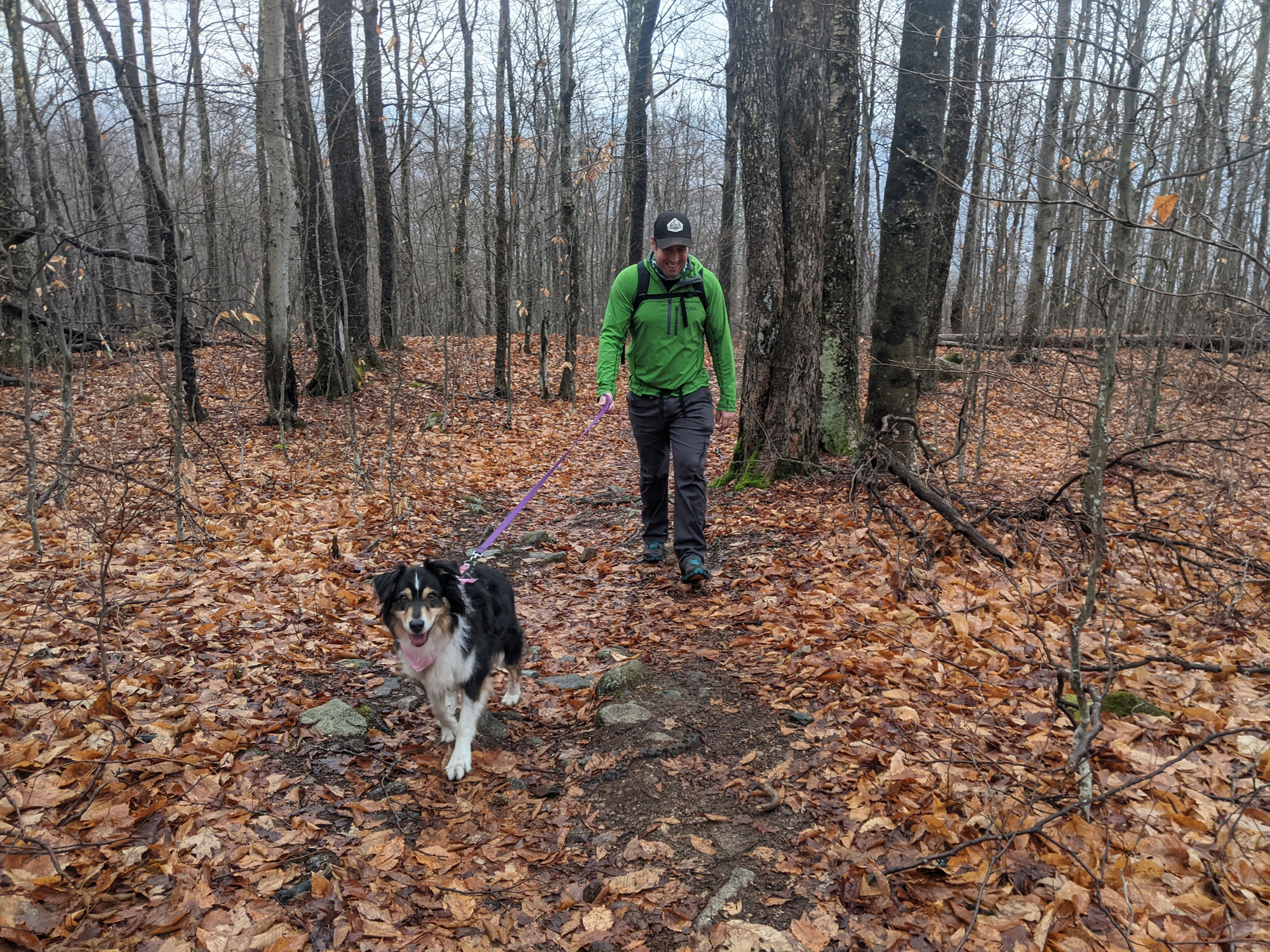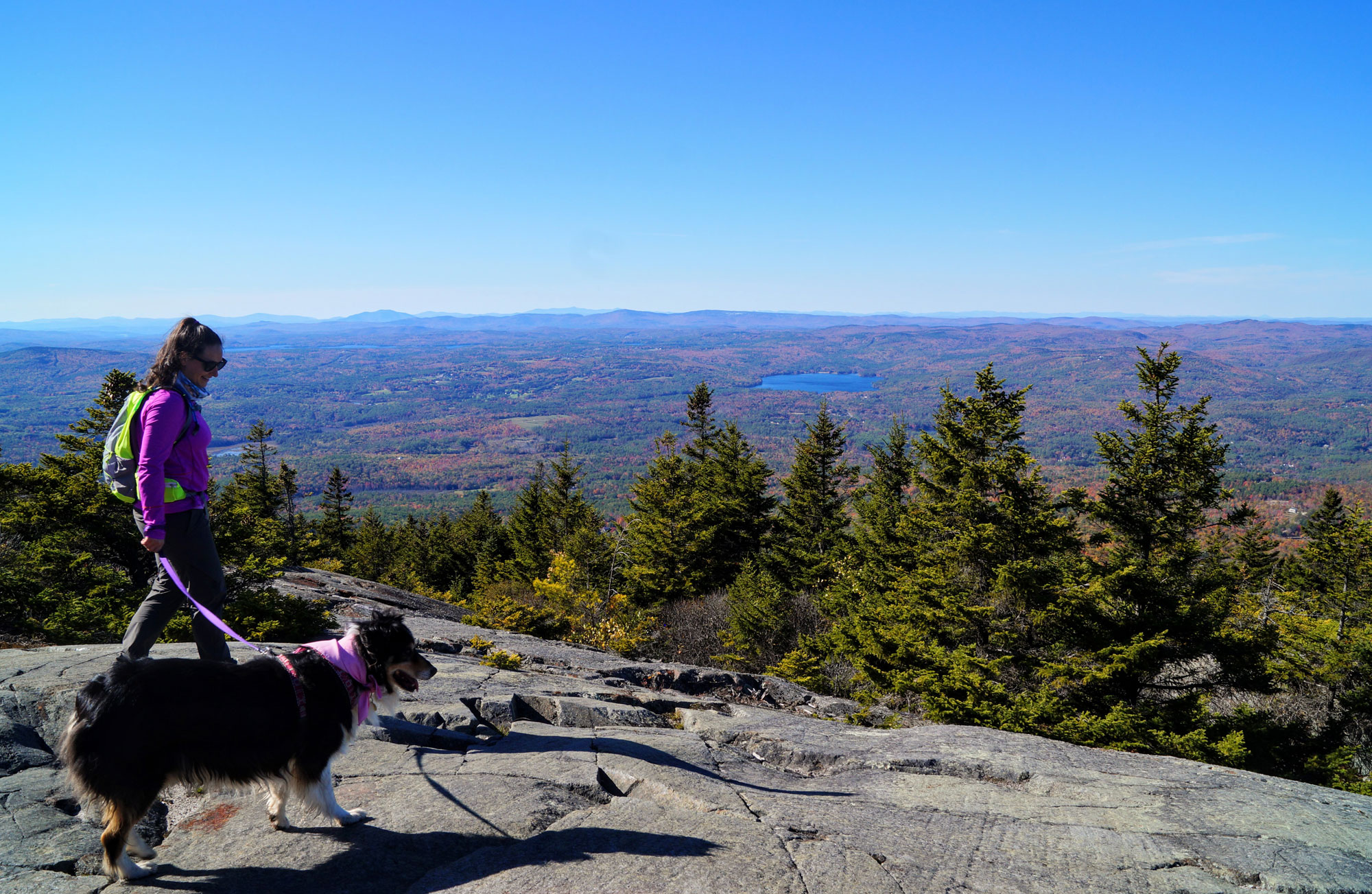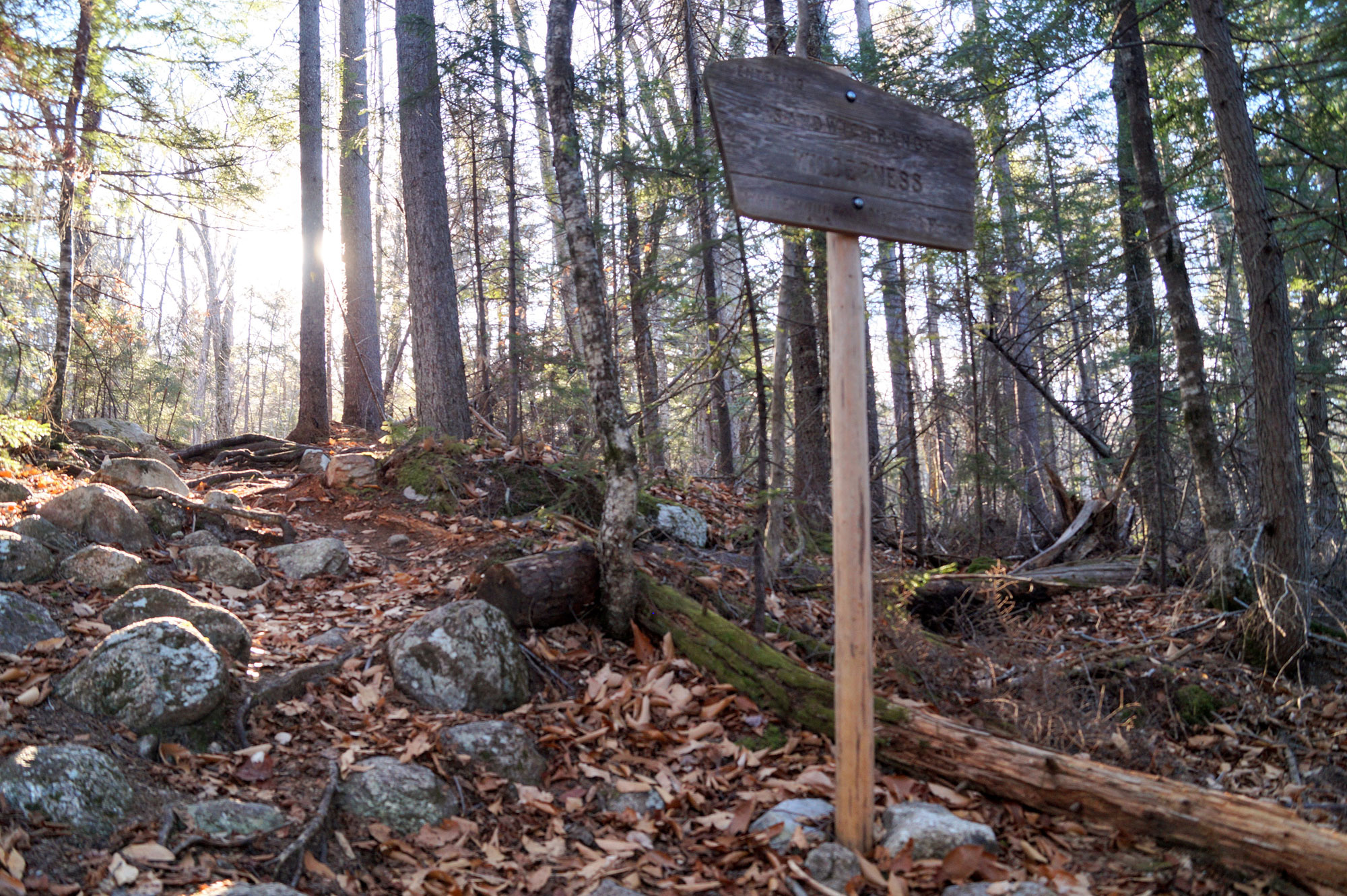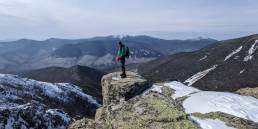The mountains of New Hampshire’s 52 With a View (52 WaV) list are known for delivering stunning scenery and epic vistas. Climb any of the 52 WaV in the fall and you’re treated to (weather permitting) the stunning sight of vibrant red, orange, and yellow leaves creating a landscape that is quintessentially New England. While all of the 52 WaV deliver big views, some are even better than others. Below you’ll find five favorite peaks from the 52 WaV that cater to all abilities and provide the perfect perspective for leaf-peeping.

1. Blueberry Mountain
Located on the western edge of the White Mountains, Blueberry Mountain offers interesting hiking, great views with moderate effort, and is a hidden gem among the more well-known peaks of the 52 WaV. The out-and-back trip to the summit of Blueberry Mountain via the Blueberry Mountain Trail is just over three miles and climbs roughly 1,000 feet in elevation.
Leaving from the Blueberry Mountain Trailhead in Benton, hikers are treated to a variety of terrain in the relatively short mile-and-a-half trip to the summit. Following yellow blazes, hikers are led along an old logging road, then enter a classic fall-colored New England forest, and eventually gain a series of slabby ledges. The pitch of the trail never gets overly steep and the ledges are generally easy to manage, provided they’re dry.
The summit of Blueberry Mountain is marked with a large cairn at the obvious height of land and is gained by a short spur path. Blueberry Mountain’s summit offers a breath-taking view and delivers awesome autumn colors. Moreover, it delivers on the way up and down, with consistent peeks at the changing colors from its semi-open ledges and an excellent perspective of Mount Moosilauke’s nearby hulking mass.

2. North and Middle Sugarloaf Mountain
The peaks of North and Middle Sugarloaf Mountain arguably offer the best payoff for your effort in New England—and are a favorite among 52 WaV finishers—which makes them a top destination of both casual and hardcore hikers alike. Leaving from the Sugarloaf Trailhead on Zealand Road, hikers follow the Sugarloaf Trail to the summits of both North and Middle Sugarloaf in roughly 3.5 moderate miles out-and-back while gaining approximately 1,000 feet in elevation.
The trail begins hiking along the Zealand River before entering the fall-colored forest and gently climbing to a saddle between the two peaks. Most choose to visit North Sugarloaf first—it offers a striking view that includes the massive Mount Washington towering across the way, but is overshadowed by the best-in-the-Whites perspective found on Middle Sugarloaf. Time your trip right and you might even see the elusive snowliage (when the summit of Mount Washington is covered in white while the low lying forest is popping with the gold, russet, and crimson of fall).
The summit of Middle Sugarloaf features a large, open, slabby area, which provides space for the crowds commonly found on this popular peak to spread out. There’s often a festive feeling on the summit, but keep your guard up, open ledges and sharp drops are lurking hazards for those caught up in the fall colors. From Middle Sugarloaf, hikers are treated to a view of vibrant colors on some of the White’s most notable peaks, including Mount Washington, Mount Jefferson, Mount Hale, and North Twin.

3. Mount Kearsarge South
Thanks to its easily accessible location in central New Hampshire, an interesting loop hike, and 360-degree views of foliage from the 2,937-foot, fire-tower-clad summit, Mount Kearsarge South is one of the Granite State’s—and the 52 WaV’s—most popular peaks for leaf peepers. A favorite way to summit Kearsarge South is from Winslow State Park in Wilmot, ascending the Winslow Trail and descending the Barlow Trail for a roughly three-mile trip climbing a touch over 1,000 feet.
While Mount Kearsarge South is similar in distance and elevation gain to Blueberry Mountain and the Sugarloafs, Kearsarge hikers will find the terrain steeper, more rugged, and likely a little more challenging. Of the ascent trails, the Winslow Trail is the more challenging of the two options—it is rockier, rootier, and the elevation is gained in less mileage—which leads most hikers to follow its red blazes up, saving the yellow-blazed, more easily navigated Barlow Trail for the way down.
No matter how you get to the summit of Mount Kearsarge South, once on top you’re treated to epic views that, on clear days, extend as far as Boston. The summit is often busy, but there is plenty of room to spread out and views to enjoy in every direction. To the south, you can view the changing leaves on Mount Monadnock and the peaks of the Wapack Range; to the north, Ragged Mountain and Mount Cardigan are in the foreground and the Whites loom large in the distance.

4. Mount Monadnock
It’s no secret Mount Monadnock is an awesome mountain—its open summit is a favorite of foliage seekers, 52 WaV hikers, and just about everyone else. Mount Monadnock lays claim to being the second-most hiked mountain in the world and is only preceded by Japan’s Mount Fuji. While most hikers choose the well-traveled White Dot and White Cross Trails, an out-and-back trip on Dublin Trail offers fewer crowds, a longer and more challenging hike, and a cool change of pace for those looking to summit this popular peak.
The approximately 4.5-mile trip, gaining more than 1,500 feet in elevation up and down the Dublin Trail, begins on the less-visited north side of the mountain at the large dirt lot on Old Troy Road in Dublin. The Dublin Trail begins benignly enough, slowly gaining elevation as it snakes through the brilliant forest decked out in its finest amber, auburn, and scarlet colors. Eventually, the trail becomes rockier and steepens, but with every step up the view improves, as more of the captivating fall landscape below is revealed.
The relative peace and quiet of the Dublin Trail are left behind on Monadock’s summit, where the peak’s enormous popularity becomes clear. Fortunately, the bare summit is expansive with no shortage of places to escape the hoards of hikers—that is if the view itself isn’t enough of a distraction. If you can peel your eyes away from the fall landscape in the foreground, it’s possible to see into all six New England states from Mount Monadnock’s treeless summit

5. Sandwich Dome
Standing at 3,980 feet in elevation, Sandwich Dome is one of the most challenging, secluded, and rewarding of the 52 WaV. Just a few feet shy of being one of the New Hampshire 4,000-footers, a hike to Sandwich Dome’s peak is more difficult than many of the NH48. A loop hike leaving from the Drakes Brook/Sandwich Mountain Trailhead along the Sandwich Mountain Trail and back the Drakes Brook Trail (with a small detour up a spur trail) nets a roughly 8.5-mile trip climbing nearly 3,000 feet and bagging three stellar viewpoints.
The first outlook along the Sandwich Mountain Trail is at the summit of Noon Peak. From here, you’re treated to a directional view prominently featuring the Tripyramids dressed in their fall finest. Following the Sandwich Mountain Trail, hikers will come across a short, steep spur trail leading to the trip’s second viewpoint—the summit of Jennings Peak. Here, your final destination, Sandwich Dome, dominates the foreground while, on clear days, you can see as far south as Mount Monadnock, assuming that you can pry your eyes from the surrounding autumn colors.
The third and final vista is on the summit of Sandwich Dome itself, which is hemmed in by scrub and low-lying bushes. Taller hikers can likely look over them, but shorter people can scale the relatively large summit cairn to take in the great view of the colors changing in the surrounding Sandwich Wilderness and pick out notable peaks like the Tripyramids, Mount Osceola, and Mount Tecumseh.
Do you have a favorite of the 52 WaV for viewing foliage? If so, let us know in the comments so we can check it out!
Tim Peck and Doug Martland
Tim and Doug met long ago at the Eastern Mountain Sports in Canton, Massachusetts. Bonding over a love of slick Quincy Quarry granite, White Mountain sufferfests, and scheming up adventures while folding tee-shirts, today Tim and Doug collaborate to write about their favorite outdoor activities and occasionally get nostalgic about tee-shirt tables.
Related Posts
April 12, 2024
Explore Like a Local: The Outdoor Mecca of North Conway, NH
There's a lot to love about this New…
April 3, 2024
5 Things To Do in the Boston Area During Mud Season
Adventure opportunities are abundant…




